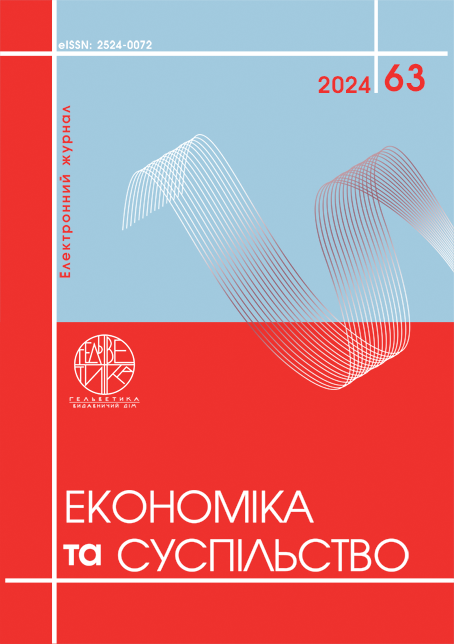FEATURES OF THE INFLUENCE OF AI ON THE DEVELOPMENT OF BUSINESS IN THE FIELD OF SERVICES
Abstract
The paper examines the specifics of the impact of AI on the development of business in the service sector, and also identifies the advantages and risks of successful integration of AI into business processes. The role of AI in personalizing service offerings and recommendations has been found to be transformative for the service industry. On the basis of the conducted research, it was found that companies' use of advanced algorithms and machine learning capabilities, through the analysis of huge volumes of customer data, will contribute to a better understanding of their preferences, behavior and needs, which in turn will allow companies to adapt offers and recommendations for each individual customer. It is clear that AI has the potential to profoundly transform the service industry by increasing efficiency, personalization and customer satisfaction, but the implementation of these technologies requires a careful approach, taking into account ethical considerations and data privacy protection. It has been established that the introduction of AI contributes to automation, personalization and optimization of service, which can lead to an increase in the competitiveness of enterprises. It was found that the use of artificial intelligence contributes to the constant development and implementation of innovations in the service sector. On the basis of the conducted research, it was found that the implementation of AI in the service sector faces certain challenges, in particular, issues of data confidentiality and ethical considerations. It has been established that the impact of AI on the development of business in the service sector is significant and multifaceted, where the main aspects of this impact include: optimization of the workforce; planning work schedules for efficient use of human resources; creating a personalized experience for customers using virtual reality and augmented reality; automation of routine and repetitive tasks, processes and optimization of the use of company resources to reduce operational costs; implementation of constant monitoring and analysis of the company's performance; identification of potentially fraudulent behavior, etc.
References
Shahin M. A. (2016). State-of-the-art review of some artificial intelligence applications in pile foundations. Geosci Front., рр. 33–44.
Huang M.H., Rust R.T. (2018). Artificial Intelligence in Service. J Serv Res., vol. 21.2, pp. 155–172.
Lovelock C.H., Wirtz J. (2007). Services marketing : people, technology, strategy. 6, illustr ed. Upper Saddle River, NJ: Pearson/Prentice Hall. 648 p.
Vargo S.L., Lusch R.F. (2008). Service-dominant logic: Continuing the evolution. J Acad Mark Sci., vol. 36(1), pp. 1–10.
Maglio P.P., Spohrer J. (2008). Fundamentals of service science. J Acad Mark Sci., vol. 36(1), pp. 18–20.
Wuenderlich N. V., Heinonen K., Ostrom A.L., Patricio L., Sousa R., Voss C., et al. (2015). “Futurizing” smart service: implications for service researchers and managers. J Serv Mark., vol. 29(6/7), pp. 442–447.
Huang M.H., Rust R.T. (2017). Technology-driven service strategy. J Acad Mark Sci., vol. 45(6), pp. 906–924.
Dirican C. (2015). The Impacts of Robotics, Artificial Intelligence On Business and Economics. Procedia - Soc Behav Sci., vol. 195, pp. 564–573.
Kurzweil R. (2005). The Singularity is Near : when humans transcend biology. VIKING. NY: Viking Press. 672 p.
Makridakis S. (2017). The forthcoming Artificial Intelligence (AI) revolution: Its impact on society and firms. Futures, vol. 90, pp. 46–60.
The impact of AI on the service business. (2024). NextGTM Consulting. Available at: https://www.nextgtm.com/blog/the-impact-of-ai-on-the-service-business (accessed June 7, 2024).
Ferreira P., Teixeira J. G., Luís T. (2020). Understanding the Impact of Artificial Intelligence on Services. Available at: DOI: 10.1007/978-3-030-38724-2_15 (accessed June 7, 2024).
Levens P. (2019). Artificial Intelligence in the Service Industry: Challenges and Opportunities. Procedia Computer Science, vol. 157, pp. 141-148.
Du Y., Zhang L. (2020). The Application of Artificial Intelligence in Service Industry. Journal of Physics: ConferenceSeries, vol. 1461(1), 012002.
Yang S., Lee J. H., Kim J. (2019). The Role of Artificial Intelligence in Service Innovation: A Systematic Review. Sustainability, vol. 11(23), 6793.
Chen Y., Lin Y. (2020). How Artificial Intelligence is Reshaping the Service Industry. International Journal ofInformation Management, vol. 50, pp. 178-187.
Grefen P., Ludwig H. (2019). Transforming Service Value Networks with Artificial Intelligence. Electronic Markets, vol. 29(3), pp. 499-505.
Autor D. H. (2019). Work of the past, work of the future. The Journal of Economic Perspectives, vol. 33(2), pp. 3-26.
Brynjolfsson E., McAfee A. (2017). The business of artificial intelligence. Harvard Business Review, vol. 95(1), pp. 60-68.
Davenport T. H., Ronanki R. (2018). Artificial intelligence for the real world. Harvard Business Review, vol. 96(1), pp. 108-116.
Manyika J., Chui M., Miremadi M. (2016). Where machines could replace humans—and where they can’t (yet). McKinsey Quarterly, pp. 1-13.
Agrawal A., Gans J., Goldfarb A. (2018). Prediction machines: The simple economics of artificial intelligence. HarvardBusiness Press.
Ransbotham S., Kiron D., Gerbert P. (2018). Artificial Intelligence in Business Gets Real. MIT Sloan Management Review, vol. 59(4), pp. 39-48.
Liang H., Saraf N., Hu Q. (2018). Transforming service innovation: A data-driven approach with artificial intelligence. MIS Quarterly, vol. 42(2), pp. 575-590.
Li X., Xu H., Tao X., Yang D. (2020). Artificial Intelligence in the Service Sector: A Comprehensive Review. Complexity.
Chen T., Duan H., Lu X. (2021). Artificial intelligence in service innovation: A systematic review and future researchagenda. Technological Forecasting and Social Change, vol. 169, 120795.
De Reuver M., Sørensen C., Basole R. C. (2020). The digital platform: a research agenda. Journal of InformationTechnology, vol. 35(3), pp. 200-224.

This work is licensed under a Creative Commons Attribution 4.0 International License.


